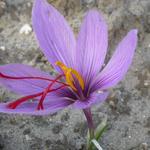E-Mail office(at)reinsaat.at
We are available by phone and our farm shop is open:
Monday – Thursday, 8:00 AM – 4:00 PM & Friday, 8:00 AM – 3:00 PM
(Lunch break 1:00–1:30 pm)
Saffron
Saffron can be ordered now, delivery - from the mid-August.
Saffron is the most expensive spice in the world and belongs to the crocuses. In principle, saffron grows everywhere where wine and wheat grow. It loves hot summer, misty autumn and snowy winter. Saffron is relatively insensitive to frost and survives cold down to -15°C.
The purple flowering plant develops its flower with the coveted three spice filaments in late autumn, after a long summer break. It is not until November and December that the majority of the leaves, also called saffron grass, develop. This remains green throughout the winter, even in extreme cold and snowy conditions. Do not cut off the leaves. In the spring - about mid to late May - the saffron grass dies back. The saffron crocus retreats into the bulb, outlasting the summer.
Cultivation:
The soil should be loose and water-permeable. Saffron does not need much water and it does not tolerate waterlogging. Saffron bulbs are planted in the soil in August at a depth of 5-8cm. The planting distance is about 5-10 cm. Always keep planting areas free of weeds!
Harvest:
Saffron is harvested by hand in late October / early November, but only in sunny weather. For this, the three orange-red pistillate filaments are plucked from the flower. After that they should be dried quickly, preferably in a dryer at 40°-45°C in about 12 min. or at room temperature - but then takes longer.
Storage:
Store the dried threads in a very well closed tin in a dry, dark room. Otherwise they lose fragrance and color.



